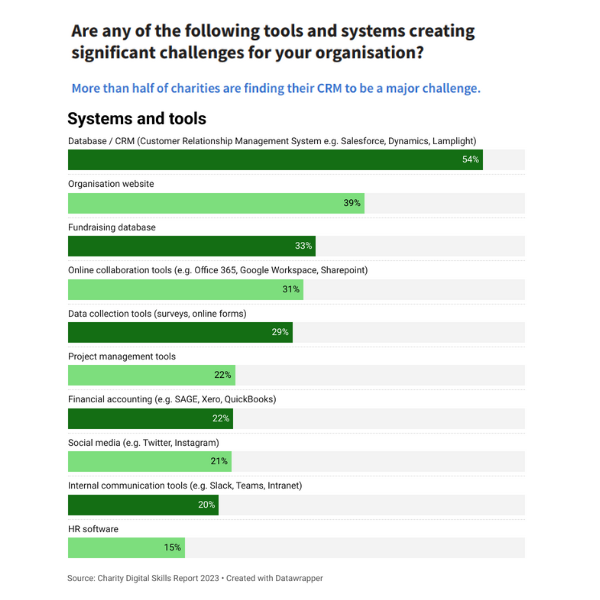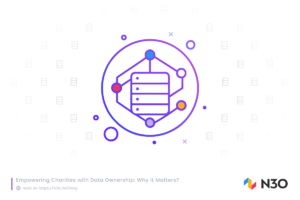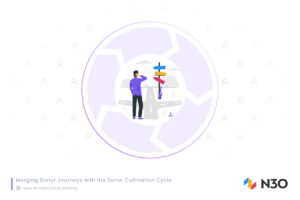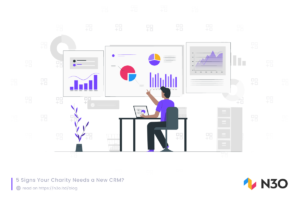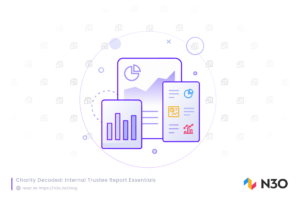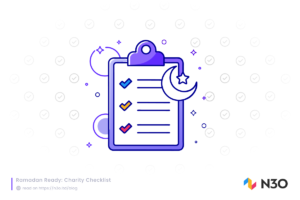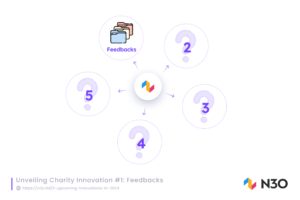A recent Charity Digital survey asked charities about their level of satisfaction with their IT provision. More than half (54%) responded that they face significant CRM challenges.
The survey indicates that charities struggling with their existing technology are finding it hard to move ahead with digital. A closer look at these challenges shows their interconnected nature, which largely results from using generic CRMs that don’t necessarily fulfil the needs of a charitable organisation.
We believe a charity CRM is not just a standalone database, fundraising platform, or donor management tool but all of these combined. A constituent relationship management tool specifically designed for charities should act as the core piece of technology that a charity relies on for all, if not, most processes.
In this article, we highlight five major signs that help you assess whether your charity lacks this core piece of technology in its IT infrastructure to operate efficiently.
Let’s find out!
1. Scattered Data
Data is central to charitable organisations. Charities must deal with multiple types of data, whether financial, donor, or compliance-related.
For instance, charities fundraise and hold their campaign data on different platforms. These include crowdfunding sites, charity websites, or even data gathered through fundraising events, which are kept separately.
In addition to fundraising data, charities use various payment gateways, such as Stripe for single payments, Zettel for fundraising events and GoCardless for direct debits – all creating multiple data sources for charities. Not centralising these multiple data entry points can be a major sign that your charity suffers from scattered data and needs a new charity CRM system to keep your data central.
These data silos lead to a no. of problems for charities, as follows:
- Inaccurate data insights or extracting insights from data involves a lot of manual work requiring time and is prone to error. “4 out of 10 charities also lack the time to focus on data” – says the Charity Digital Skills Report 2023.
- Fragmented or disjointed view of supporters across multiple disconnected platforms or even manual records, rather than being consolidated into a single, comprehensive view within the CRM.
- Compliance issues can arise if your donor’s consent data (such as Gift Aid and communication preferences like email or SMS) is not up-to-date and reflected across the relevant systems.
Did you know?
“The UK supervisory authority for data protection is the Information Commissioner’s Office (‘the ICO’).” The same office is the GDPR’s regulator. GDPR applies to all personal information you may collect and retain about your beneficiaries, users, donors, staff, and volunteers, among others. Ensure you know the data your charity possesses and how it is managed. Read UK GDPR guidance and resources to learn more about the subject.
These and other data-related challenges result in charities having less time to focus on data (cause) while they continue resolving secondary issues (effect).
2. Donor Complaints
If your donor care team receives frequent donor complaints that have a pattern to them, that’s another major sign you need a new CRM.
The main consequence of donor complaints is loss of trust. Donor complaints can come from a variety of perspectives. One example is related to donation receipts, feedback reports or general transactional communications. The receipts may be delayed or not received at all. All such issues lead to a loss of trust in your organisation.
Trust in charities from the public is multifaceted and intricate, shaped not only by effective regulation but also by the conduct and practices of individual charities. Negative conduct by a single charity can significantly impact the public’s perception of charities as a whole.
Did you know?
“53% [of donors] agree that charities are generally trustworthy in 2022, compared to 50% in 2019 and 48% in 2018.”
“Responsible use of funds” remains the most important trust factor:
To demonstrate trustworthiness, charities need to show that they:
- Use funds responsibly – with donations being spent highly efficiently, prioritising the services, activities, and people that advance the charitable cause.
- Make a positive difference (have an impact) through their work.
- Consistently follow and apply ethical values and principles in every aspect of their work.
According to the UK Charities Commission, “Ensuring that the money is used well is consistently reported as the most important factor of trust in charities. People want to know their money is making a difference on the front line.”
- Poor impact reporting can be another major cause of dissatisfaction. It is a common challenge, where charities struggle to provide feedback for projects they have raised funds for or annual reports of their orphan sponsorships. Lack of feedback is usually caused by charities doing this manually since their systems are disconnected and data is scattered.
- Worse than lack of communication are mistakes in donor communications, such as addressing donors incorrectly, duplicate communications, or sending irrelevant solicitations, which may frustrate donors and result in complaints. This can happen when your team does not have a unified view of supporter profiles. This can become a blocker to delivering a personalised communication experience.
In short, your cluttered processes can make timely issue resolution difficult. If this sounds like your charity, then you need to find a new charity CRM.
3. Inaccurate Figures
The third sign that you need to transition to a new charity CRM is data discrepancies. Data coming from multiple sources may not be recorded in a standardised form. The resulting asynchronous data can hinder your organisation’s ability to use data for decision-making, reporting, and improving operational efficiency.
Charitable organisations rely heavily on data. This is why:
“Data remains one of the top three key priorities for charities, with 59% wanting to use data and insights to improve their services or operations, similar to last year – says Charity Digital Skills Report 2023.”
- Lack of data synchronicity then creates ‘Data Silos’. Without a centralised system, data often ends up siloed in different departments or systems. As a result, understanding the charity’s operations becomes challenging. For example, the donor care team might have one set of donor information in the CRM, while the finance team has another set in the accounting software. Changes or updates made to one data set might not reflect in others, leading to discrepancies and inconsistencies in donor records.
- Difficulty reporting and compliance: Reporting becomes cumbersome when data is spread across various systems. For instance, compiling financial reports for audits or regulatory compliance can be time-consuming and error-prone. You might face challenges presenting these figures to senior management, the C-suite or trustees – resulting in data-related trust issues.
- The risks of inaccurate donation records: If donation records are duplicated or incorrectly recorded, the charity might mistakenly believe it has more funds available than it actually does. This can lead to overspending, budget shortfalls, and, ultimately, financial instability for the organisation.
- Setting unrealistic expectations or organisational goals: Overstating the success of a particular fundraising event or campaign can lead to unrealistic expectations for future efforts and potentially damage donor trust when outcomes don’t align with expectations.
Did you know?
“Charity Transparency Data Research Report 2022 states that Participants wanted financial and impact data about charities to be easily and quickly accessible in an engaging, visual and simple format. This is important for them to learn about and to ‘know’ the charity and develop a closer understanding of how the organisation is going about making a difference to the cause that they care about.”
Switching to a CRM that centralises your data flow can address these and many other data-related issues that are keeping your charity stuck in a data black hole.
4. Parallel Activities Outside Your CRM
Lots of manual processes being done outside the CRM is another sign your charity needs a new CRM. For instance, if you run fundraising campaigns on 3rd-party crowdfunding sites and cannot import them into the system, then campaign data would be sitting outside the CRM.
This is when your charity CRM doesn’t have the technical ability to import. It is a common issue among generic CRMs used across the sector, causing charities to manage their data manually or invest in databases to maintain information outside the CRM.
- Limited integration between these individual databases creates yet another challenge of data sharing. For instance, direct debits processed through your direct debit provider rather than your charity CRM would require manual reconciling later. If not imported correctly, key donation data can be lost.
For example, if a donor donates towards a food pack for Yemen, you may end up using their contribution towards another project due to the lack of recorded data points. As a consequence, impact measurement suffers.
- Lack of charity-specific features: Multiple software for different processes might also mean that your charity CRM does not have the ability to manage Sponsorships or Feedbacks (mini-projects like water wells or health clinic construction) within the CRM. So, you are implementing them outside the CRM, relying on Excel sheets and manual creation of reports.
When it’s time to share an orphan pack or project progress report with the donor, you must extract information from different data sources. This is a lack of automation, which could greatly hinder your team’s productivity.
Did you know?
“Spending less time on administrative tasks is a growing need for charities, at 37% compared to 31% last year. This may be where tools such as ChatGPT and increased automation could help charities.” – Charity Digital Skills Report 2023
This finding indicates that charities want more time to focus on mission-critical aspects of their work rather than being drowned with redundant administrative tasks. This is where automating certain parts of your charity CRM processes comes in handy, replacing your old technology that does not support it.
5. Low Team Collaboration
If your teams are operating in silos, the projects team is separate from the donor care team and doesn’t have access to the same data. Then, it’s time for your charity to look for a new charity CRM.
- The difference between a good and a poor charity CRM is the need to look for data in different places. If there is a donor complaint, then the finance team, projects, or the donor care team should all be able to access the central system and confirm whether the donation has been made or not.
A good charity CRM is like a central resource that everyone can use. Its data is correct, and everyone is updated on each other’s tasks. Not having a shared and central database can create collaboration challenges.
- Inefficient Communication: Lack of a centralised system hampers communication between teams. For instance, if the programs team needs to access donor information to provide updates on how donations are impacting beneficiaries, they may have to request data from the donor care team, causing delays and potential miscommunication.
- Off-the-shelf CRMs can be too simplistic and may require third-party support which can become an unnecessary expense. On the other side, overly complicated CRMs can also be difficult to administer.
Did you know?
A Stanford University study found that teams that collaborate effectively are 50% more productive. This highlights the direct link between successful teamwork and increased productivity. When team members work well together, they complete more tasks and projects in less time.
Due to poor collaboration, about 64% of workers report losing at least three hours of productivity per week. As a result, charities may miss out on opportunities for raising funds from donors.
Switch to a Charity-Specific CRM
If your charity is struggling with poor IT infrastructure, it will likely end up facing many of the challenges mentioned above. If so, it may be better to switch to a solution that fulfils your needs and helps your charity grow rather than stall its progress.
It’s important to note that being aware of your requirements is fundamental to choosing the right tool. Although there are plenty of options available, not all CRMs can cater to a charity’s diverse needs. This is why it’s paramount that you focus on charity-specific CRMs rather than generic CRMs. The difference between the two is huge.
Charity-specific CRMs like Engage are designed and developed specifically for charities and address their requirements. Generic CRMs are not industry-specific and are general-purpose pieces of technology made for a wide array of industries.
To learn more about their difference and how charity-specific CRM outperforms generic CRM read a detailed comparison here.
PS: Join our mailing list now and learn about industry insights and charity tips to improve your charity’s day-to-day operations.
